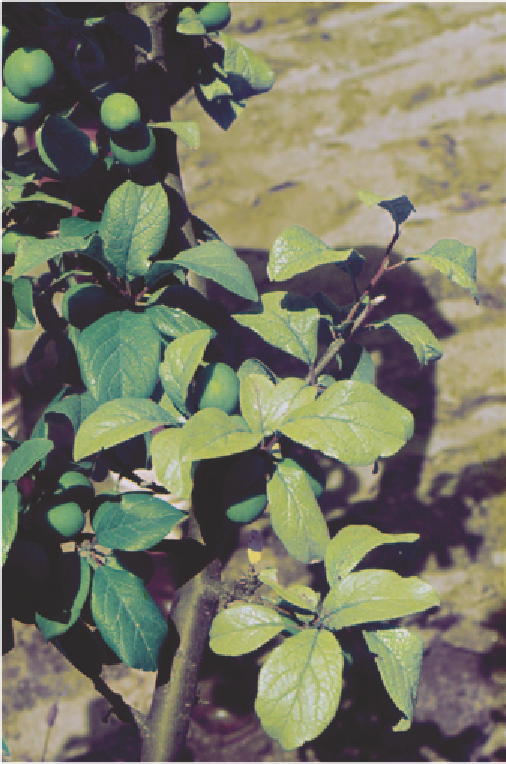Agriculture Reference
In-Depth Information
-
hastening leaf fall in autumn, and making sure
fallen leaves are completely broken down before the
beginning of the next season.
mite can also cause leaf silvering, although this mite
seldom causes serious commercial infestations in
Australia. Silver leaf always occurs in conjunction with
trunk and limb infections, while peach silver mite only
affects the leaves.
In severely infected orchards, a dormant application
of lime sulfur will reduce overwintering inoculum.
•
Silvering is caused by a fungal toxin carried through the
water-conducting tissues. In silvered leaves, the epidermis
peels away readily when rubbed or scraped.
Silvering usually appears first in a few small shoots, but can
extend rapidly to all leaves of an infected branch. The
extent of leaf silvering is related to the size of the trunk or
limb wound that was initially colonised.
SILVER LEAF
■
Cause
The fungus
Chondrostereum purpureum
(previously
Stereum purpureum
).
Symptoms
Leaves: leaf silvering is characteristic and is usually the
first symptom noticed on infected trees, although trunk
or branch infection has occurred some time earlier.
Affected leaves have a pale grey, metallic sheen in
contrast to the deep green of healthy leaves. Use caution
when assessing this symptom, because the peach silver
Trunks and limbs: initial infection of trees occurs through
wounds. Pruning wounds are especially prone to infection.
Once inside the tree, the fungus produces toxins that kill the
wood in trunks or branches. Dark brown discolouration of
the trunk or limb heartwood is diagnostic for this disease.
Once the limb has died, fungal fruiting bodies appear on the
bark. Fruiting bodies are small, leathery structures with a
greyish white upper surface and a purplish lower surface.
Infected plants slowly decline over several seasons.
Source of infection and spread
The fungus can infect all types of stone fruit and many other
temperate trees and shrubs, including pome fruit, willows,
eucalypts and roses. Spores of the fungus are produced on
infected branches, or on old stumps and prunings. They can
be blown for considerable distances and enter trees through
fresh wounds. Wet weather favours infection.
Importance
Silver leaf is a minor disease of leaves in Queensland, and
can cause slight to moderate yield losses from branch death
in wet years. However, it is an important disease in the
southern production areas of the Goulburn Valley and the
Adelaide Hills, where it can be an aggressive wood-rotting
pathogen, causing significant reduction in fruit size,
number and quality.
Management
•
Remove and dispose of affected trees well away from
growing orchards.
Avoid pruning on calm, damp, overcast winter days
because this is when spores will be most active.
•
Prune trees carefully and shape young trees to avoid the
need for large pruning cuts.
•
Use good-quality, sharp pruning tools - ragged wounds
help the fungus to colonise tissues.
•
Fig 17.25 Silver leaf symptoms caused by a
Stereum
infection.












